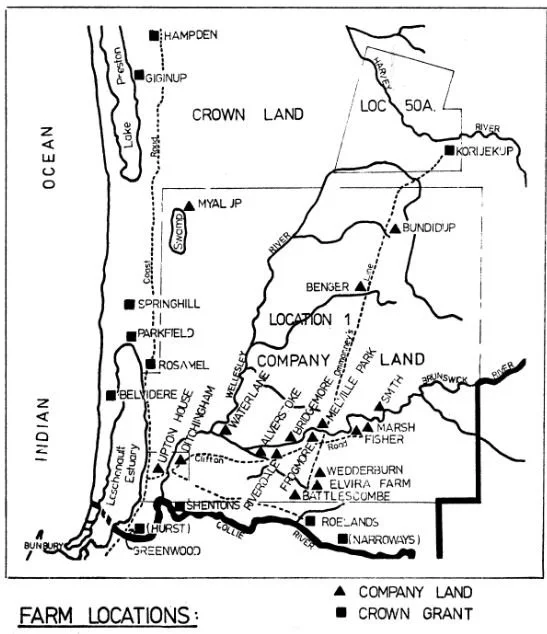FLAHERTY FAMILY OF WELLINGTON LOCATION: ROELANDS, BRUNSWICK & PICTON
JOHN FLAHERTY (1815 - 1897)
John was the eldest son of Edward and Sarah Flaherty (nee Chapman) and came to Western Australia on board the Gilmore in 1829 with his parents and six siblings (reference, p34). The ship had
“182 passengers, three horses, four cows, three calves, pigs and fowls” (reference).
This was one of three ships that brought immigrants to the fledgling Western Australia Colony, part of Thomas Peel’s vision of a better life, which ultimately failed (reference). The family first settled at Clarence Beach but atrocious conditions of their once fellow passengers dying of dysentery saw them move to Bassendean by 1832 when the first of the Australian born Flaherty children arrived.
ROELANDS
John moved to the Roelands district when his father became J S Roe’s tenant, sometime in the early 1840s (reference).
The first known record of John is in 1848 in Marshall Waller Clifton’s diaries. Clifton was the former Chief Commissioner of the Western Australian Company of the Australind Settlement, another failed scheme. Clifton’s diaries are an insight into the early years of European settlement in the Wellington location. However the entry briefly states of an affair that John was conducting with Mrs Whitely, who at one time was Clifton’s servant. Clifton persuaded Mrs Whitely to break off the relationship with John and return to her husband (1).
In 1851, John lodged a legal notice in the Perth Gazette & Independent Journal of Politics & News, of stray stock on his land. The notice was signed in Bunbury, being the nearest Law Court to Roelands, approximately 23kms away (reference).
Later in that same year, John and his father signed a petition in which the WA Colonists objected to an increase in salaries to people claiming to represent the Council, one of whom was M W Clifton (reference).
In Clifton’s diary entry for January 6th, 1853 he mentioned travelling to J Flaherty’s property, giving it a location of near to a ford across the Collie River. Also by referencing John as opposed to his father, assumes by that time, control of the property had been given to John (2).
A letter to the editor of the Inquirer on June 25th, 1856 listed farmers in the area (reference). The location given for John is confusingly Treendale, not Roelands. This may be an oversight by the letter’s author, but the list includes well known local identities such as John and Robert Scott, the first European settlers in Bunbury.
Records show a John Flaherty married Anne Brennan at Dardanup in 1856. No death records exist for Anne Flaherty so unsure whether this marriage is for John of Roelands (reference).
But what is confirmed is that in 1865 John married Mary Anne Fisher (widow of Henry) (nee Marsh) at Brunswick (reference). Mary Anne was born in 1819 in England and arrived in Western Australia in 1853 with Henry and their children (reference, p28). Henry later purchased 100 acres on the Clifton Road near the Brunswick River but died in 1862 and Mary Anne transferred the property to her eldest daughter (3).
In 1867 John signed a petition objecting to the early removal of the then Governor of WA, His Excellency John Stephen Hampton. He signed the Australind petition, whereas his brother Edward Jnr (also a farmer) signed the Bunbury petition (reference).
In The Herald Western Australian Almanack editions for 1873, 1874 and 1877 John is listed as being a farmer in the Brunswick District, which encompassed Roelands; exact location unknown. (reference; reference; reference). Surprisingly, in the 1875 edition he is listed as a farmer in Bunbury district, not Brunswick (reference).
BRUNSWICK
In 1878 John Septimus Roe, John’s landlord died and in 1879 the estate was put up for sale. The notice in The Western Australian Times February 4th, 1879, shows a change in tenant, being W B Mitchell, probably William Bedford who was a former manager of the Prinsep Estate (reference). In 1881 Robert Henry Rose purchased J S Roe’s property for his son (reference).
John remained farming in the Brunswick district during 1881 - 1884 (reference; reference).
In 1885 he purchased locations 42, 43, 44 Clifton Road, Brunswick (reference) . These blocks were bounded on the south by the Clifton Road and all other sides by the Brunswick River and they were located to the west of Beela, where brother-in-law James Mylne had 500 acres reference (p 185); reference, p8). John is still listed in the Brunswick district in 1887 (reference).
BUNBURY
John and Mary Anne moved to Swamp Road (now Beach Road), South Bunbury, where he passed away in July 1897, aged 82 (reference). Probate was granted to Mary Ann and their house was advertised for sale in December 1897(reference; reference)
Mary Anne continued living in Swamp Road, but died in 1905 in very tragic circumstances; she was burnt when her clothes caught alight from a wood fire and died from her injuries (reference).
John and Mary Anne were buried at the Bunbury Anglican Cemetery (now known as Pioneer Park) in an unmarked grave (reference).
1. Phyllis Barnes, J M R Cameron et al (eds.); Australind Journals of Marshall Waller Clifton 1840 - 1861 (Carlisle, WA: Hesperian Press) p306
2. Barnes, Cameron et al (eds.); Australind Journals of Marshall Waller Clifton p437
3. A C Staples; They made their destiny - History of settlement of the Shire of Harvey 1829 - 1929 (Bunbury, WA: South West Printing & Publishing Co P/L) pp 153-155

